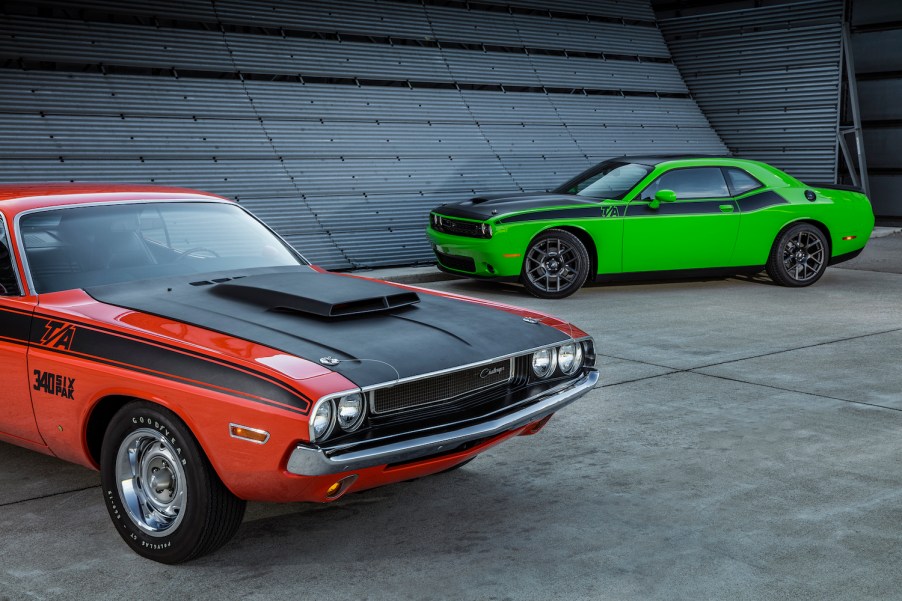
This 1971 Dodge Challenger With a New Challenger Front Clip Is the Worst of Both Worlds
Sometimes, when I’m scrolling through eBay before beginning the day’s articles, I stumble across a crazy vehicle. Sometimes, it’s so strange, so inane, even so hair-brained, that I have to share it with you, dear reader. This 1971 Challenger with a new Dodge Challenger front clip is one such find. You may consider it a harmlessly modified old car. But no, this monstrosity spits in the face of everything about vintage automobiles that I hold dear!
The first-generation Challenger is special

Back in 1970, Dodge rocked the automotive world with a bigger, more powerful pony car, a “challenge” to the Mustang and Camaro. The 1970 Dodge Challenger was a muscular mid-size coupe well suited to a Hemi V8. Though only in production for a few years, it became a cultural icon.
Not only did the Dodge Challenger race into the public consciousness when it did well in the Trans-America Championship, but it caught Hollywood’s attention too. It has starred in films from 2001’s Vanishing Point to Tarantino’s Death Proof, 2 Fast 2 Furious, The Bucket List, and 2 Guns.
Some might even call the short-lived Dodge Challenger the quintessential muscle car. It was a bare-bones vehicle engineered for affordable straight-line speed. It looked good and could hold its own in a drag race, but was far from a luxury car.
Dodge rebooted the Challenger

Eventually, the classic Challenger inspired a retro reboot: the 2008-present Dodge Challenger. The FCA engineers and designers managed to build a modern coupe with the look and feel of the powerful old muscle car. In some ways, the new Challenger was even better.
While the original Challenger’s base slant-six engine turned out a measly 145 horsepower, the new Challenger’s entry-level Pentastar V6 makes 292 ponies. And don’t get me started on the top end: The 1970 Dodge Challenger’s absolute top-trim engine was the exceedingly rare 426 Hemi V8 sold just for NASCAR homologation purposes. It made 425 horsepower. A Hellcat would eat that V8 for breakfast.
Then after breakfast, that Hellcat could put on cruise control, sit back on its haunches, and purr along as a darn comfortable commuter. Crank the A/C, connect the Apple CarPlay, and you’re enjoying more luxury than even a 1970 Chrysler could dream of. Oh yeah, and if someone hits you, you have something called an airbag to save your life.
Why would you drive a 1971 Dodge Challenger in the first place?
Driving a vintage muscle car is a commitment. The tires are skinny, so even the best-tuned brakes require increased stopping distance. The HVAC system may be restored, but modern considerations like multi-speed fans and automatic windshield wipers were not on these engineers’ minds.
Driving an original Challenger is a statement, as much about what its driver gives up as what they gain.
Part of that statement is the simple, narrow, Challenger front end. There are the sealed beams, the skinny tires, and the complete street-brawler muscle car look. There’s not much more to take away. This aesthetic mirrors the philosophy of driving an old car. This is why so many vintage vehicle drivers can’t walk away from their cars without looking back and smiling. It touches a part of their soul.
This brings me back to the Franken-Challenger. Why in the world would a driver of a vintage Challenger want to pull that car apart and throw a new Challenger’s body on it? The result is all bark and no bite.
I’ll admit, I could understand wanting to throw a body kit on an old Challenger. Modifying a muscle car to look more modern could be cool, it worked for the Eleanor Mustang. But the problem is that Dodge already did that! There are many new Challengers with powerful drivetrains that would be a much better base for such a project.
Secondly, if some automotive enthusiast and fabricator built and drove a vintage Challenger with the front clip of a new car, I’d say, “Good on you!” I’m a big fan of “Live and let live.” But here’s what boggles my mind: This Challenger is for sale (half done) as if it is a desirable project!
You won’t be surprised to hear that someone already swooped in and bought the valuable vintage engine and transmission out of this Challenger. So all that’s left is the Franken-Challenger’s empty shell, listed for $19,995. That’s more than a 2010 SRT8 is going for! But if you’re so moved, you could go to eBay and buy it to prove me wrong.
Next, read my 1970 Dodge Challenger buying guide or watch a race between an old Challenger and new Hellcat in the video below:






